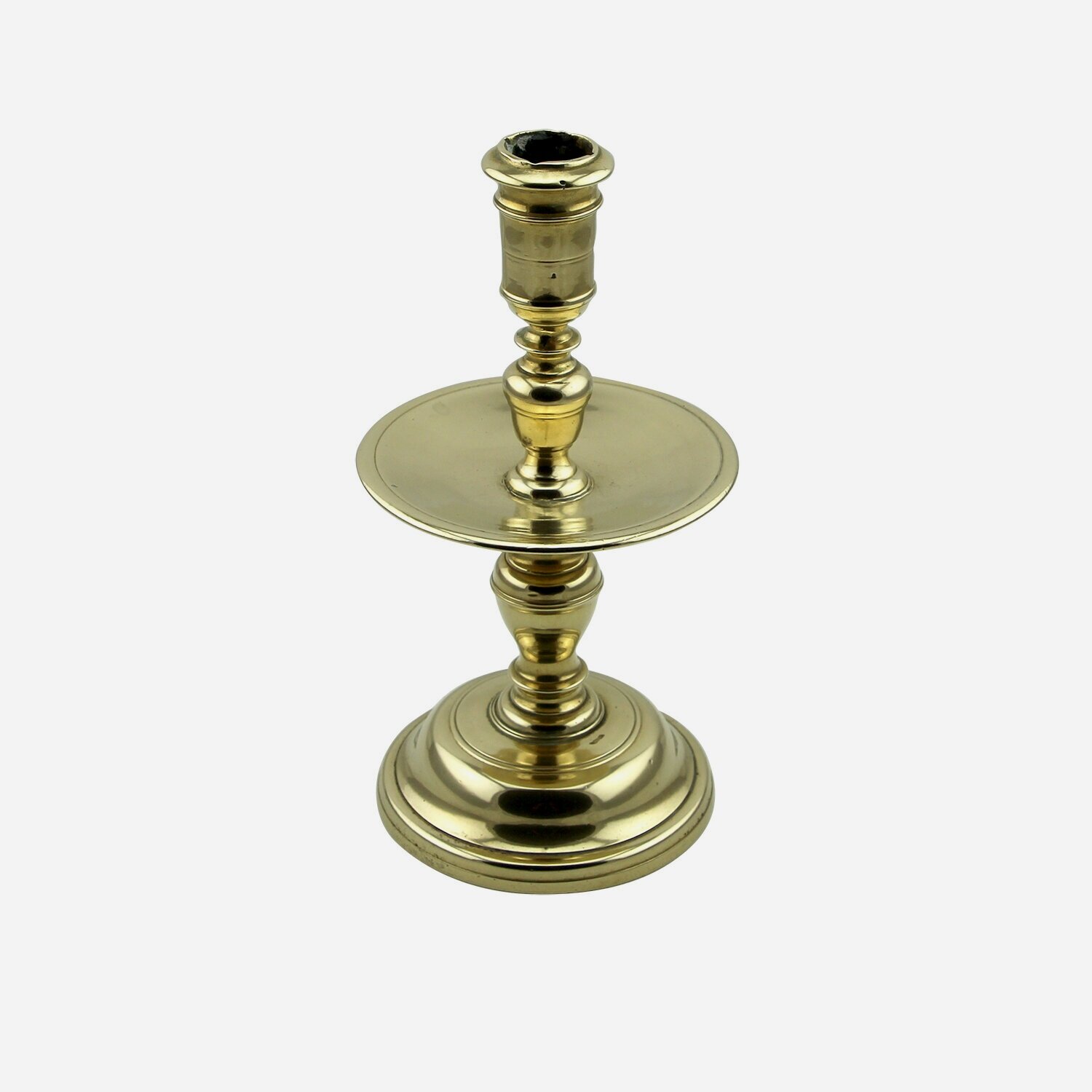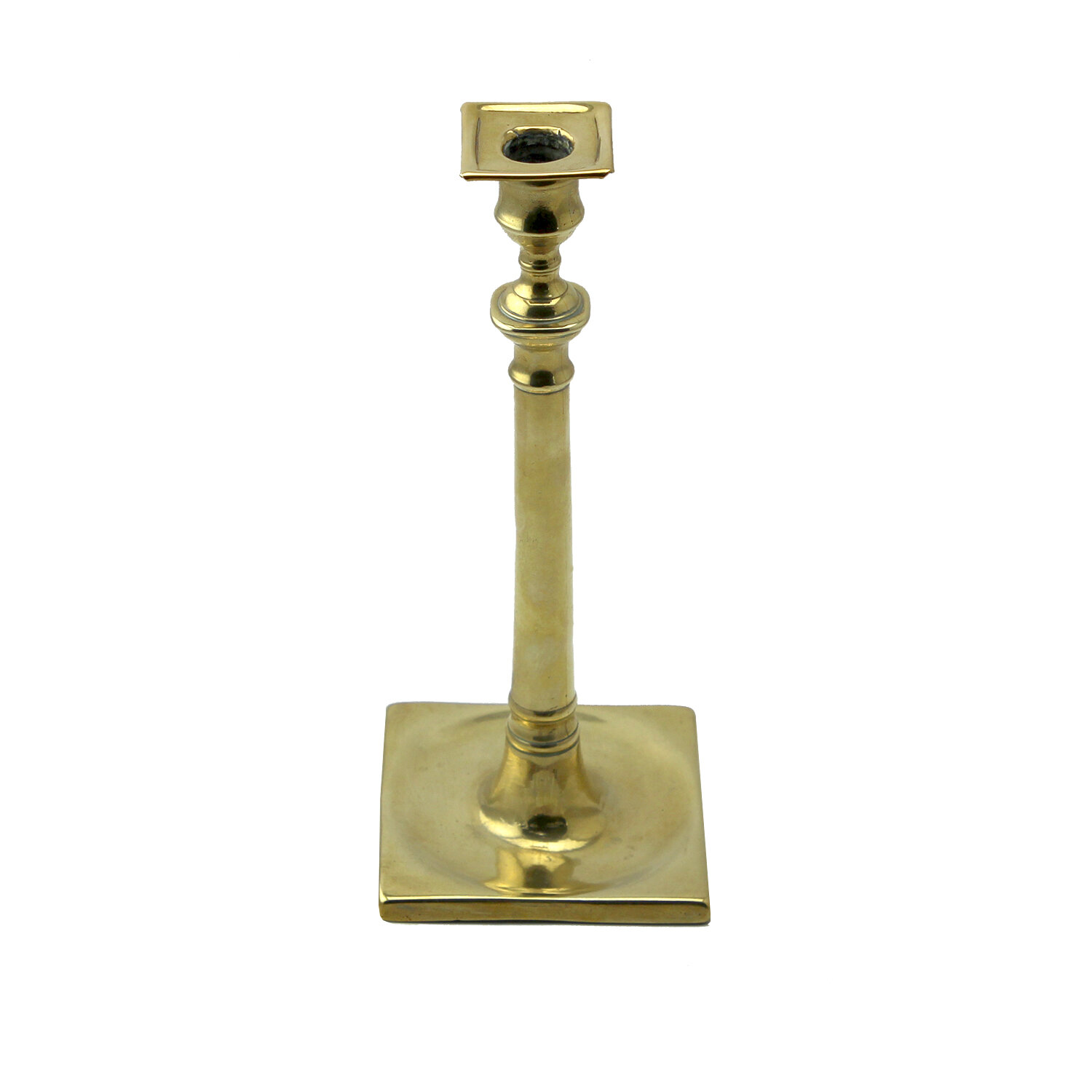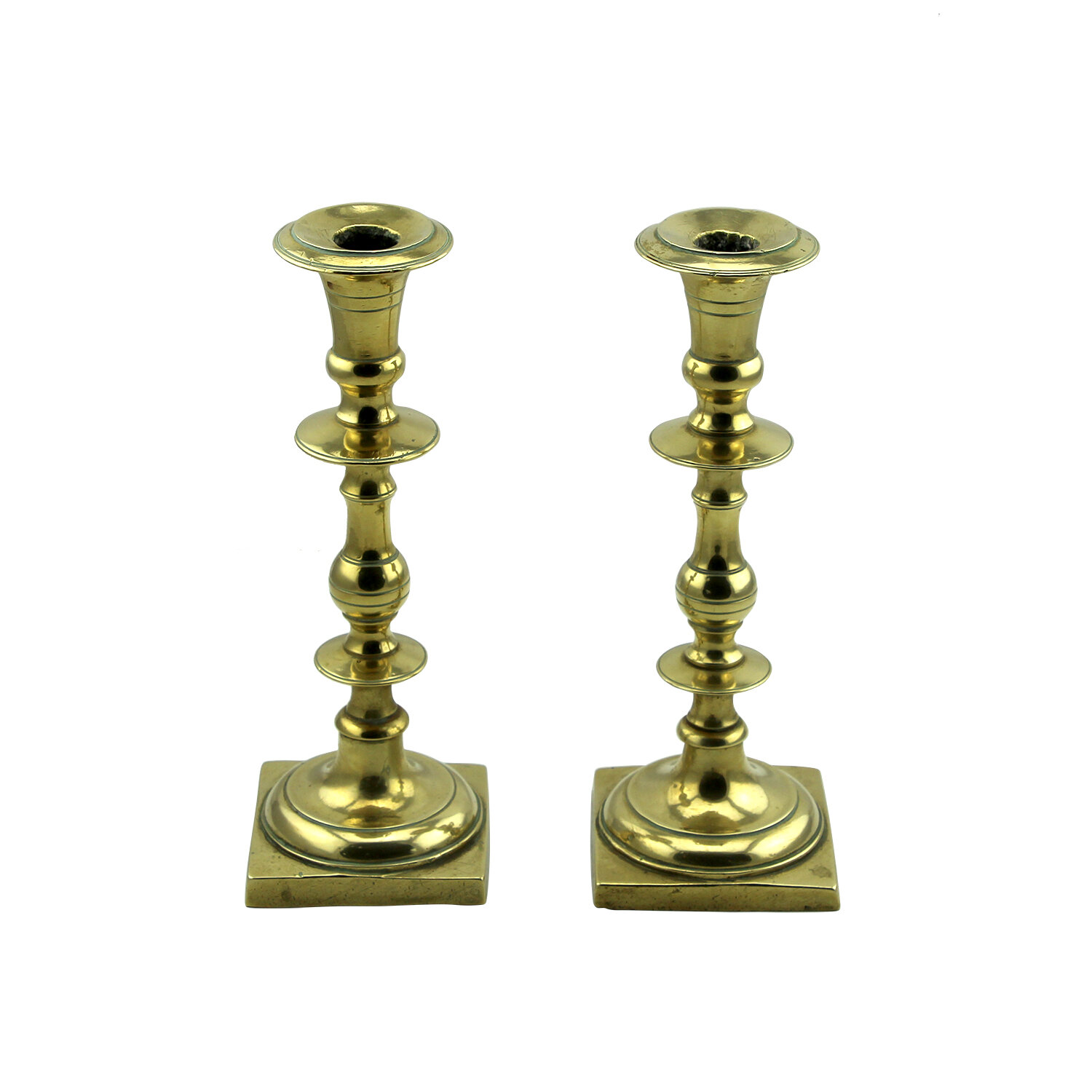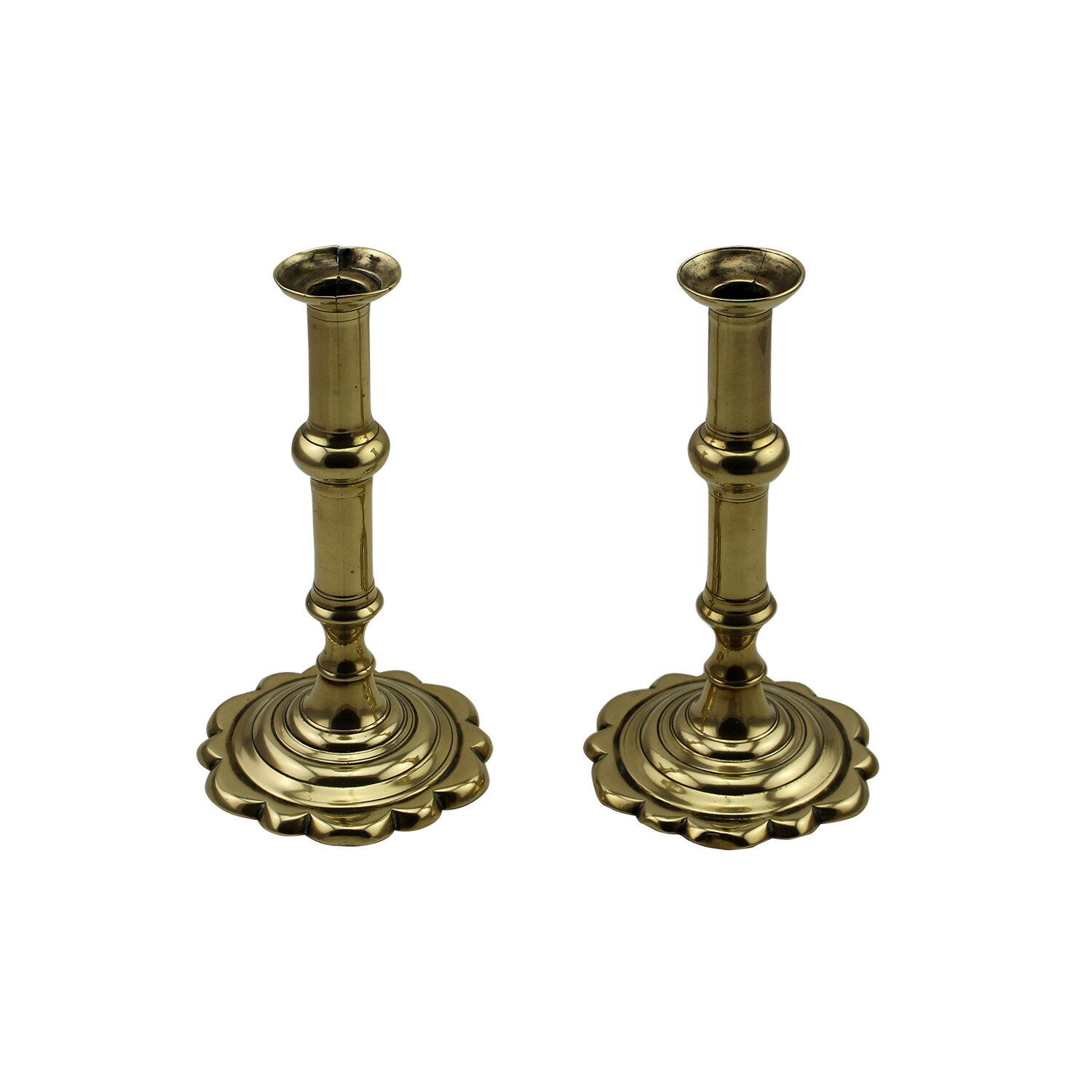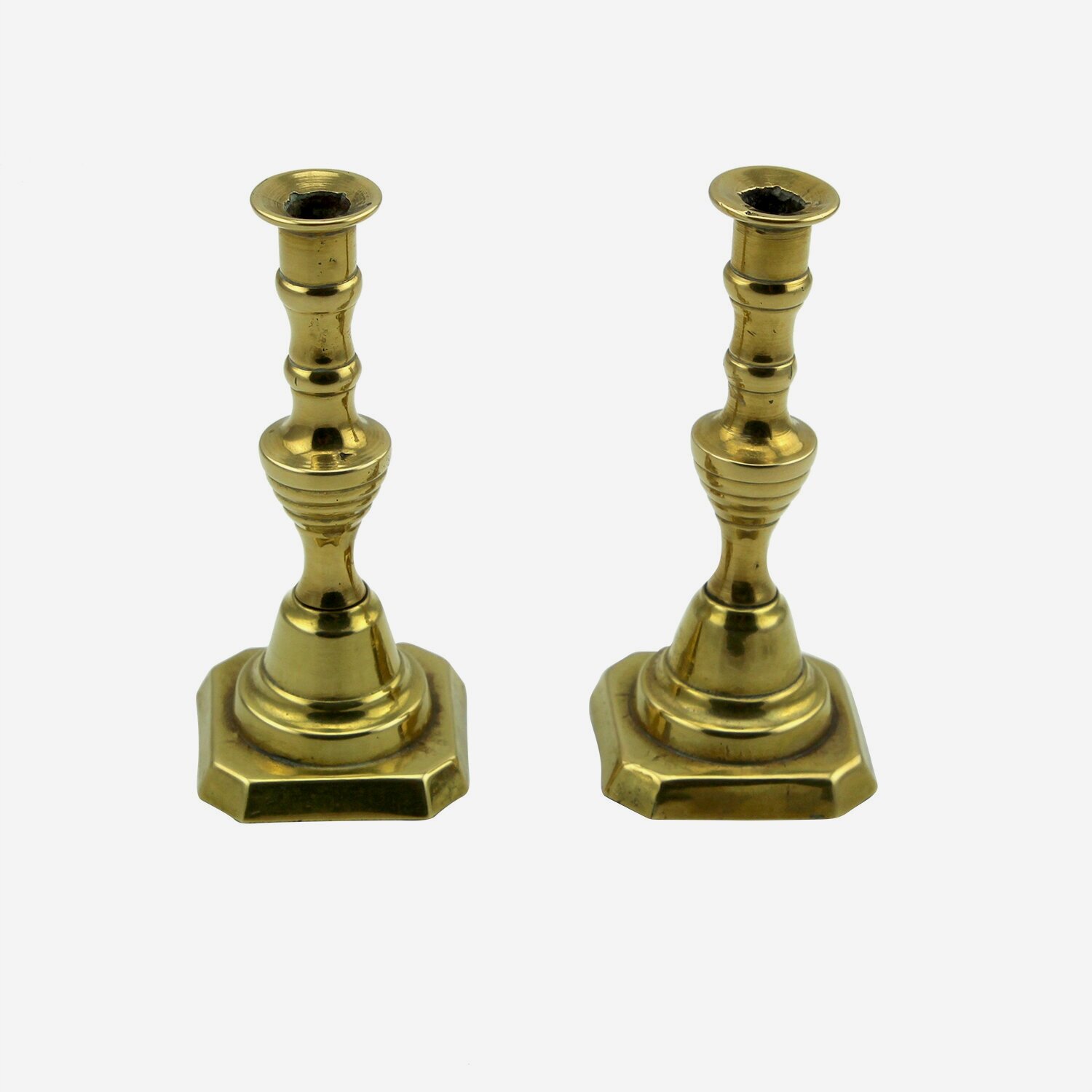The History of Candlesticks
Candlesticks are among our favourite antiques - superbly crafted, they create an intimate and memorable setting, and make excellent gifts. This Insights article outlines the origin of the candlestick and the history of the design through the ages. A candlelit setting can make any table romantic and special!
English brass candlestick with ridged ball knop, and trumpet shaped foot, with drip pan half way up the column. Complete with socket hole to remove candle wax. The body is cast in four sections then joined. The practical design was heavy enough to sit securely on a rough table yet suitable to be carried around the house as required, the drip pan being high enough to protect the hand from hot melted wax. English circa 1650. Size: 9 h in
The origins of candle making go beyond the common era to the times of Ancient Greeks and Romans. What started as a relatively simple process of repeatedly dipping a strand of twine into tallow has evolved into a whole elaborate industry. Human beings have always needed fire for safety, food and, most pressingly, light. Ancient candle artefacts made from animal fat, olive oil or beeswax were discovered throughout the Middle East and Asia. Indigenous communities of the Pacific Coast used small fish called eulachon – also known as “candlefish” – due to its high percentage of body fat it can be lit like a candle when put on a twig.
Alongside the candle-making grew the need for candleholders or candlesticks. These too have gone through many iterations of materials, form, and function. Later candlesticks benefitted from centuries of ingenious improvements that occurred during the 17th century. Both the stem and the base of candlesticks used to be made of solid brass. It is common for examples of that era to have a hole in the socket to remove the candle stump which would frequently get stuck. However, the 18th century brought a wave of innovation in candlestick design. First, instead of being constructed in solid brass, candleholders were made in two vertical halves.
When these were brazed together a hollow space was left inside and you can see a line from the softer brazing material. This space allowed the production of slide ejectors with a handle on the side or push-rod ejectors underneath the base. Both of these would push the tail end of the candle up the stem for it to be easily removed. The process was further simplified by the development of casting the stem in one piece using a removable core (called hollow core casting) which allowed for a much finer and thinner product.
The form of the candlestick has also gone through several transformations. Until middle of the 18th century, most candlesticks had large drip pans – a vertical plane attached to the middle of a candlestick to prevent the candle from dribbling. These often were placed half way up the column to protect the hand from hot melted wax. However, as the candles began to be produced from a superior quality of tallow, these drip pans were no longer necessary and the candlestick stem could be decorated with increasingly intricate designs. During the Queen Anne period, candlesticks emblematic of that era had an octagonal shaped stem and round base without decoration. Early Georgian examples are also quite elegant and plain, perhaps with hexagonal or cut-corners base. During the mid-18th century, French Rococo influences transformed the candlestick stem
into a masterpiece of floral decorations, asymmetrical designs brought into being by casting the base from independent pieces and soldering and chasing it afterwards. Later Georgian candlesticks featured gadrooned rims or baluster shaped stem with a series of knops. The bases, previously only round or square, were shaped into petal, swirl or scallop designs.
Pair of George III short brass candlesticks with tapered, baluster shaped stem with drip flange sitting on square bases, English circa 1790-1800. Later Georgian examples such as these were constructed with a slightly softer brass alloy of a rich golden colour and tended to be finished with more care. These examples incorporate an interesting method of attaching the hollow column to the foot by spreading the ‘tang’ after insertion in the foot until tight. Size: 5 ½ h in
To celebrate the Diamond Jubilee of Queen Victoria, James Clews and Sons of Birmingham designed a series of candlesticks that were first made in 1897. They were the ‘Ace of Diamonds, ‘King of Diamonds’ and ‘Queen of Diamonds’ and the designs proved so popular that they were still in production until the start of the war in 1939. Each candlestick has the name stamped on the base. The Prince design was registered on 18th January 1902 as No. 385856 and the Princess as No. 392433; on occasion the numbers are confused between the two designs as in this case.
Paktong
The secret Paktong alloy was developed in China in the 16th and 17th centuries; the word is the Cantonese pronunciation of the Chinese word “pai-t’ung’ which means white copper. It is a tough alloy of mostly copper and zinc, with small portions of nickel and iron. Being very hard Paktong is therefore long-lasting and does not corrode, scratch or damage easily. Light in colour, it pales to yellow when tarnished.
Paktong was first introduced to Europe in the mid 18th century. Ornate candlestick styles produced by silversmiths in silver were very popular, but were rarely copied in brass. They were, however, occasionally copied by silversmiths themselves in Paktong. These rare examples are seldom marked and can be dated to within a few years of their comparable silver counterparts. The imported Paktong alloy was precious and there was no success, even after analysis, in reproducing the formula in Europe. The secret formula for the high-grade alloy was lost after a few years and does not seem to have been used after circa 1775.
Tapersticks
Tapersticks are small table candlesticks designed to hold a wax taper, a small thin tapered tallow candle. Many tapersticks are miniature copies of the period table candlesticks of their era. Early examples had minimal decoration and simple waisted sockets. By the mid 18th century styles had evolved to include gadrooning, fluting and other examples of Rococo decoration.
These small tapers were frequently required during daily 18th century life when they first became popular. Often tapersticks were included as part of inkstands, as letters were often sealed with wax melted over the small tallow candle flames and then impressed with an intaglio carved with initials or the family crest. Tapersticks also served as chambersticks, as they were small and light and easy to carry from room to room, as well as for the purpose of lighting other candlesticks or for the lighting of tobacco.
Tapersticks are much rarer than the larger table candlesticks and few existed before the age of Queen Anne. Because of their most common uses, they were generally made individually, and pairs are extremely rare.
Georgian sterling silver taper stick, the knopped stem with bold shell corners to shoulders and terminating in shaped square bases with shell motifs to corners, complete with bobèche, London 1762, maker WC. Size: 5 ½ h x 3 square in
Pair of diminutive brass taper/candlesticks with beehive turning, vertical faceting and square base with cut corners, English circa 1850. Size: 4 h in
Candle Snuffer
While the candle snuffer's component parts might still be familiar to us - scissors, a stand, dustpan - combined, they do look quite baffling. However, before electricity, candles and candle snuffers were an integral part of everyday life. Candle wicks used to be made of cotton which would start smoking and burst into flames as they grew longer, therefore necessitating regular trimming. The scissor part of the candle snuffer would sever the burnt wick, which would safely fall into the dustpan to be extinguished and discarded. This would also catch any dripping hot wax.
Early 19th century brass candle snuffer and stand. The octagonal based stand with shaped handle holding a snuffer with scissor-like handles and pointed tip. English circa 1840. Size: 7 ½ h x 2 ¾ square in


